Solving problems in the courier delivery and logistics department is way more complicated than anyone can think. It requires courier management, delivery partner management, schedule management, delivery vehicle management, warehouse management, sender/receiver information management, location management, payment management, etc.
What if all these processes can be streamlined within an app? Great, right? Yes, that is possible with a well-featured parcel delivery app that simplifies all your complex process management.
What is a Parcel Delivery App?
A parcel delivery app facilitates the seamless and streamlined delivery of packages from one location to another.
It serves as a digital platform connecting customers, delivery service providers, and businesses, enabling them to manage and track the entire delivery process effortlessly.
With the exponential growth of e-commerce and the increasing demand for quick and reliable shipping solutions, parcel delivery apps have revolutionized the logistics industry, offering convenience, real-time tracking, and enhanced customer experiences.
Why Is There a Need for a Parcel Delivery App?
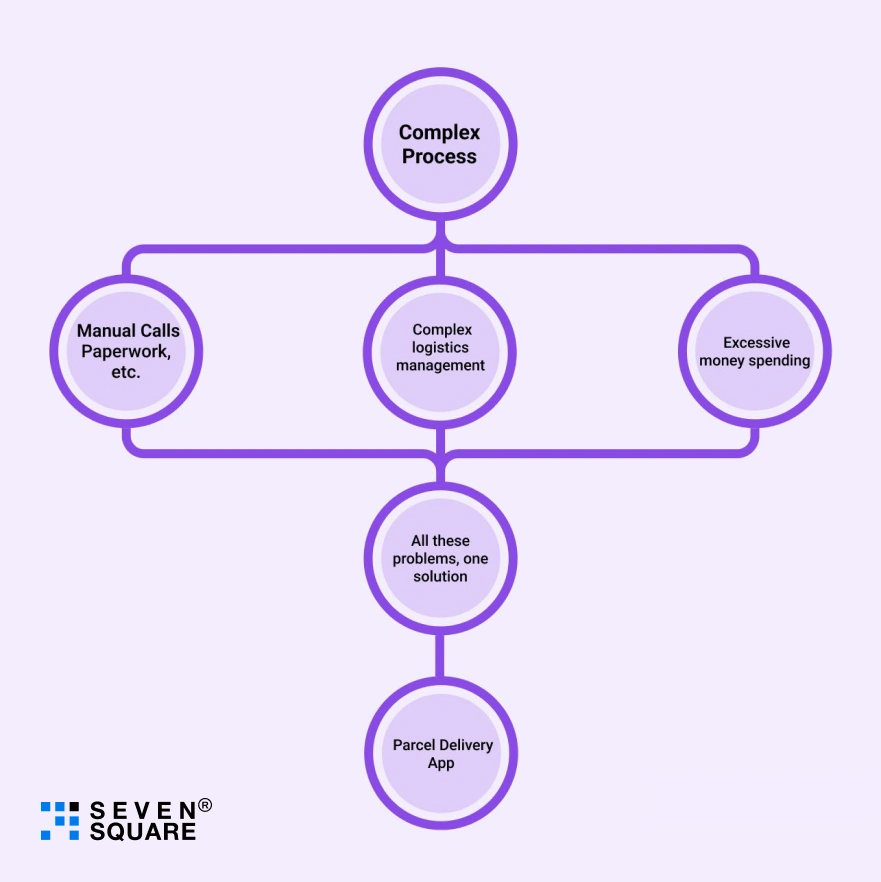
In today’s fast-paced world, where convenience and efficiency are valued more than ever, the need for a parcel delivery app has become increasingly apparent. Developing a parcel delivery app can streamline all the processes involved in the business, offering numerous benefits for both businesses and customers alike.
Firstly, a parcel delivery app eliminates the hassle of traditional delivery methods, such as phone calls, paperwork, and manual tracking systems.
- By digitizing the entire process, businesses can streamline their operations and save valuable time and resources.
- From placing an order to tracking the delivery in real time, all the steps can be seamlessly managed within a single app, providing a convenient and user-friendly experience.
A parcel delivery app enhances transparency and communication between businesses and customers.
- Through the app, customers can easily view the status of their deliveries, receive notifications and updates, and even communicate directly with the delivery personnel.
- This level of transparency builds trust and satisfaction, as customers feel more informed and engaged throughout the entire delivery process.
A parcel delivery app can optimize route planning and logistics management with advanced algorithms and data analytics.
- Businesses can efficiently allocate resources, minimize delivery times, and reduce fuel consumption.
- This enhances operational efficiency and contributes to environmental sustainability by reducing carbon emissions.
Furthermore, a parcel delivery app opens new opportunities for businesses to expand their customer base.
- Businesses can attract tech-savvy customers who prioritize convenience by offering a user-friendly app that simplifies the ordering and delivery process.
- Additionally, the app can provide valuable insights into customer preferences and behavior, allowing businesses to personalize their services and enhance customer satisfaction.
In conclusion, the development of a parcel delivery app is crucial for businesses aiming to streamline their processes and meet the growing demands of modern consumers.
Investing in a parcel delivery app is a strategic move that can lead to increased efficiency, customer satisfaction, and long-term success in the industry.
Benefits of Parcel Delivery App
The parcel delivery app brings more to the table than simplifying processes involved in parcel receiving and delivering operations. Here are some of the main benefits of parcel delivery app:
Reduces costs
The parcel delivery app eliminates manual processes such as making phone calls, paperwork, manual counting, etc., which helps businesses reduce costs and can be utilized to enhance applications and expand services in other domains.
Efficient Delivery Scheduling
Schedule your delivery partner’s allotments through the app, with the use of GPS, search for nearby delivery partners, and send them delivery requests accordingly.
Saves Time
This app saves time by eliminating the manual processes in the whole process. With the implementation of a route optimization algorithm, one can save time on delivering parcels and deliver multiple parcels to multiple locations in the time of one.
Live Tracking
No need to call drivers, warehouse managers, and other related partners for updates. You can track your parcels and delivery partners with the help of a live tracking feature.
Get Rid of Paperwork
No need to carry all the documents now together anywhere you go! Keep all your products verified through the parcel delivery app.
Now that you know all the benefits of having a parcel delivery app start thinking about having one!
So, Where and how to start with? Don’t worry; we are here for that only! We will guide you with steps to follow in order to start developing a parcel delivery app.
Guide to Develop a Parcel Delivery App
This guide provides a step-by-step overview of the key considerations and essential elements involved in developing a successful parcel delivery app.
1. Define Your App’s Objectives
Before diving into the development process, defining your objectives and understanding the market landscape is important. Identify your target audience, their needs, and the specific pain points you aim to address with your app. Conduct market research to gather insights about your competitors, industry trends, and user expectations.
2. Plan Your App Features
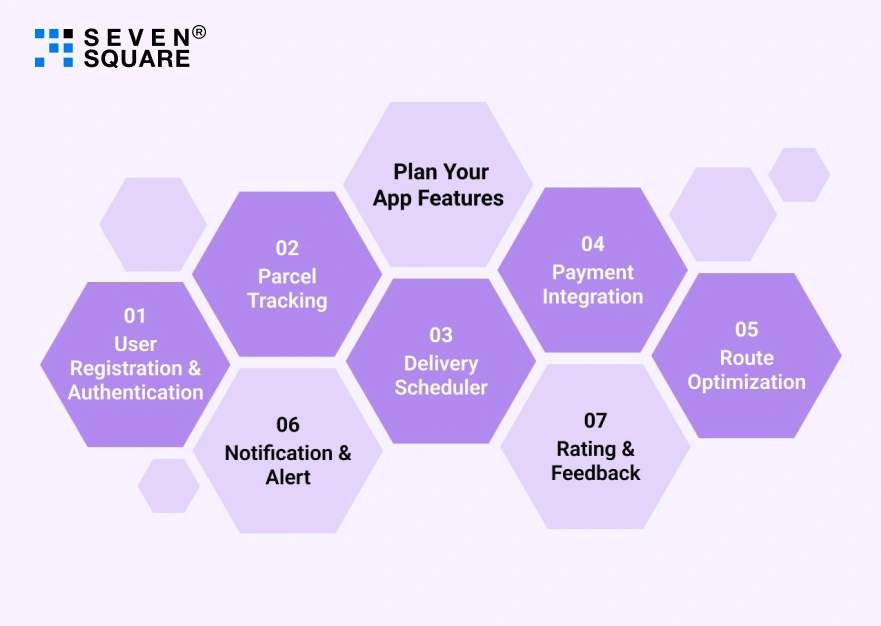
Outline your parcel delivery app’s core features and functionalities. Here are some key features to consider:
a. User Registration and Authentication: Allows users to create accounts, sign in securely, and manage their profiles.
b. Parcel Tracking: Implement real-time parcel tracking using GPS technology, enabling users to monitor the status and location of their packages.
c. Delivery Scheduling: Users can schedule pickups and deliveries at their preferred times, ensuring flexibility and convenience.
d. Payment Integration: Integrate secure payment gateways to facilitate seamless transactions and support multiple payment options.
e. Notifications and Alerts: Send push notifications and alerts to users regarding parcel status updates, delivery confirmations, and other important information.
f. Rating and Feedback: Enable users to rate their delivery experiences and provide feedback, fostering trust and continuous improvement.
3. Design User-friendly Interfaces
Focus on creating an intuitive and user-friendly interface for your app. Prioritize simplicity, clarity, and consistency in design. Consider employing a clean and minimalist visual style, making it easy for users to navigate through the app and access the desired features effortlessly.
4. Develop the Backend Infrastructure
It plays a critical role in the smooth functioning of your parcel delivery app. Establish a robust and scalable server infrastructure that can handle high traffic, secure user data, and ensure efficient communication between users, delivery personnel, and the app.
5. Implement GPS and Mapping Services
Integrate GPS and mapping services to enable accurate tracking and real-time location updates for parcels and delivery personnel. Leverage APIs such as Google Maps or Mapbox to provide precise geolocation services within your app.
6. Ensure Security and Privacy
As your app deals with sensitive user data, prioritize security and privacy measures. Implement encryption techniques, secure data storage, and adhere to relevant data protection regulations. Conduct regular security audits to identify and address vulnerabilities proactively.
7. Test and Refine
Thoroughly test your app’s functionality, performance, and usability across multiple devices and platforms. Conduct beta testing with a select group of users to gather feedback and identify areas for improvement. Continuously iterate and refine your app based on user input and emerging industry trends.
8. Launch and Market Your App
Once you are confident in the stability and usability of your parcel delivery app, prepare for its launch. Develop a comprehensive marketing strategy to create awareness, attract users, and gain traction in the market. Utilize digital marketing channels, social media platforms, and partnerships with relevant businesses to promote your app effectively.
Developing a successful parcel delivery app requires careful planning, attention to user needs, and a robust technical infrastructure.
By following this guide and focusing on delivering a seamless user experience, you can create a valuable and competitive app that caters to the growing demands of the parcel delivery industry. Remember to adapt and evolve your app based on user feedback and emerging market trends to stay ahead in this dynamic landscape.
How Does the Parcel Delivery App Make Money?
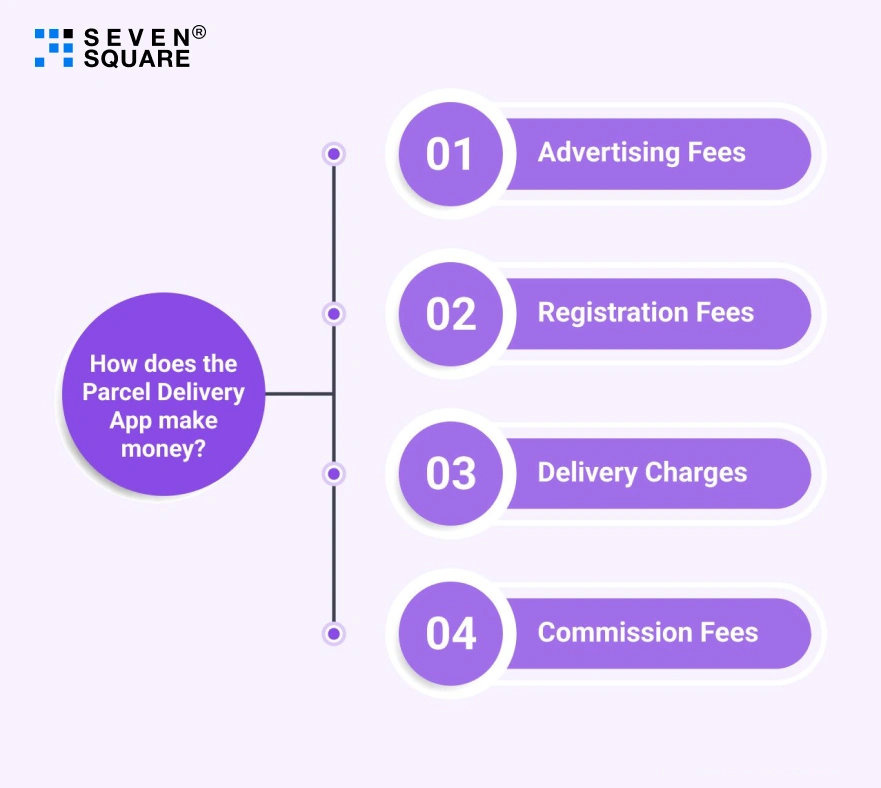
These parcel delivery apps make money through different revenue models. Some famous revenue models from which parcel delivery apps make money are Advertising Fees, Registration Fees, Delivery Charges, and Commission Fees.
Advertising Fees: Allow relevant and authenticated third parties to put advertisements through your parcel delivery app. But keep in mind that there should not be too many advertisements in your app. That will ruin the user experience of the app and will decrease the user-retention ratio of your parcel delivery app.
Registration Fees: Charge your app users for some special services or for trying to use a subscription model which benefits both app users and app admin. To attract more users to your app and to increase the user-retention ratio, offer coupons & rewards to your users.
Delivery Charges: Start taking delivery charges according to the delivery location premises. Decide on a price chart that depends on various factors such as distance, weather, courier weight, etc.
Commission Fees: One can set the commission ratio based on their preferences and make money from it.
Why hire Seven Square Technosoft?: We have an MVP ready waiting for you!
We are a team of passionate tech enthusiasts dedicated to providing their best solutions at work. We are here to provide real-time solutions to all the real-time problems and more.
We are working on different domains such as Mobile App Development, Web App Development, UI/UX Designing, Testing & Deployment, on-demand Application Development, Digital Marketing, etc.
Being in the field of development, we have worked on many on-demand application development projects and delivered them successfully to our clients. Here is one of the parcel delivery applications we’ve developed to solve some real-time problems of our clients.
Have a look at our case study:
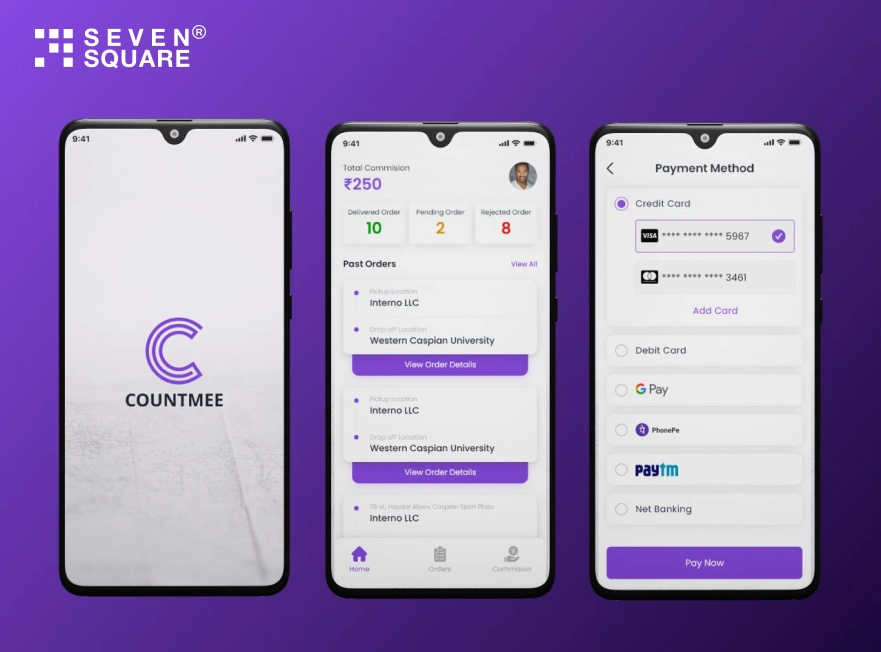
Problem Statement:
– The traditional process of sending parcels from one location to another can be time-consuming and lacks efficiency.
– Customers often face challenges finding reliable and convenient delivery options, while delivery partners struggle to access consistent opportunities and optimize their routes.
– There is a need for a comprehensive and user-friendly solution that connects customers and delivery partners while streamlining the entire parcel delivery process.
Our Solution:
– Introducing Countmee, a cross-platform mobile app designed to revolutionize the parcel delivery and logistics industry.
– Countmee provides a seamless platform connecting customers and delivery partners, allowing customers to send parcels easily from one location to another.
– We created a system in which there can be multiple pickup-drop stops to optimize routes according to the availability of delivery partners.
– The app includes two separate interfaces, one for customers and one for delivery partners, ensuring a smooth and efficient experience for both parties.
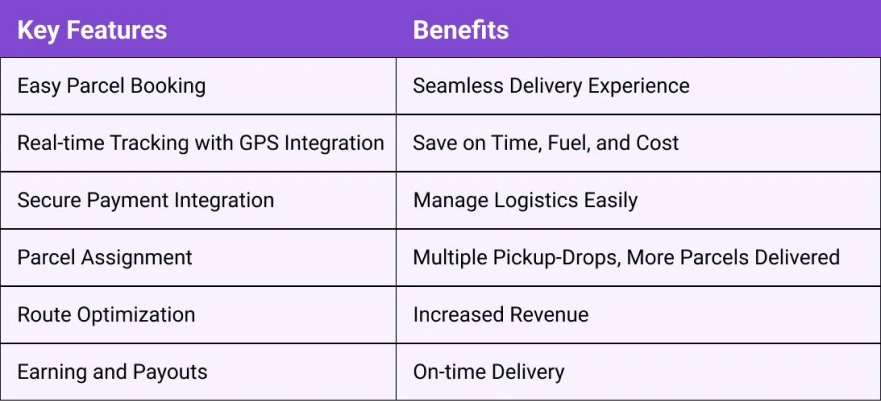
Develop a parcel delivery app with us as we have a basic MVP ready for you. If you need to launch the first version of the application within a few days, then we are the right fit to be your development partner.
You are at the right place if you have anything specific in mind or want to customize the whole project. We offer top-notch development services from research to deployment along with post-deployment services.
Also, we provide you with a highly-skilled team having a project manager, developers, sales manager, designers, and QA engineers. Our team will provide you with constant updates and reports related to work.
FAQs
- Parcel delivery apps can help to improve operational efficiency, minimize manual errors, and increase customer satisfaction.
- Usually, they offer features like real-time tracking, automated updates, and delivery route optimization to make logistics smooth.
- Customers can easily schedule deliveries, track packages in real-time, and get instant notifications.
- These apps can save time, provide transparency, and offer convenience by eliminating the need for manual follow-ups.
- Technologies like Flutter, React Native, and Kotlin are used for app development, while Firebase and AWS handle the backend.
- APIs for GPS tracking, payment gateways, and map integration are necessary components.
- Real-time tracking uses GPS technology to monitor the parcel’s location. Integrated maps and APIs provide live updates so that users and delivery personnel can get the status of the package.
- These apps can be highly secure if features like encrypted payments, two-factor authentication, and secure databases are implemented to ensure customer data and transactions are protected.
